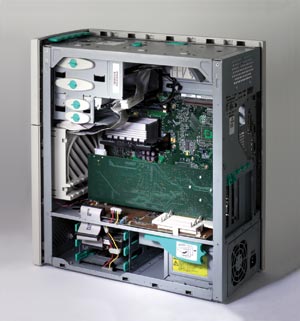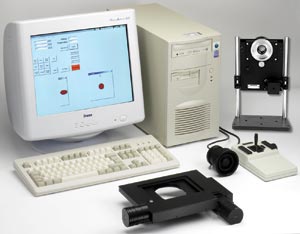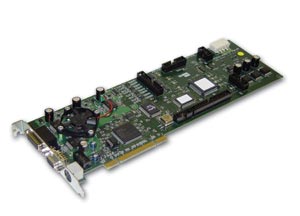The rapid communications speed, space-saving ability to plug directly into the computer bus, versatility and affordability of the PCI controller card make it a viable and sensible approach to the automation of microscope functions.
Michael DeJonge and James Hunt, Prior Scientific Inc.
Over the past 15 years, microscopes have been transformed from devices for which the operator had to adjust the stage position, focus, filters and shutters by hand, into advanced systems in which these functions are automated.
This has paved the way for optical techniques such as calcium-ratio imaging, 4-D multidimensional imaging, precision deconvolution and time-dependence analysis. In the biological sciences, automation has saved investigators countless hours by allowing them to record data from live cells at numerous positions for time-lapse studies. In industrial applications, automation has made scanning samples and specimens much faster and more precise.
Researchers always are searching for ways to improve microscope automation, however. One of the latest innovations is the PCI card, which enables the microscopist not only to collect more images, but also to image a larger sample in a given time frame, resulting in higher-quality data and more accurate results.
PCI and its benefits
A computer bus transfers data and/or power among the computer, its subsystems and connected devices. PCI cards are so named because they are installed into the peripheral component interconnect bus of standard computers. From the perspective of the user of an automated microscope, this connection means that the PCI bus takes the place of RS-232, USB, FireWire or other means of data transfer.
The original computer bus of the early 1980s was the ISA, or industry standard architecture, which could transfer data at rates of up to 8 MB/s. The next generation was the EISA (extended industry standard architecture), which transferred data at up to 32 MB/s.
The PCI bus became readily available around 1990. Despite PCI being relatively new to the microscope automation market, its use has increased dramatically in a relatively short period, primarily because of its communications speed. Researchers want to obtain the maximum performance from an imaging system, and the ability to rapidly capture images is a key performance criterion when selecting a system.
PCI data transfer rates range from 132 MB/s to 1 GB/s at operating frequencies of 33 to 800 MHz. Even the slowest PCI card transfers data more than 100 times as rapidly as the fastest RS-232 connection and more than twice as rapidly as USB.
The PCI card also enables the user and the system to read the position of the automation accessories in real time. Imaging software thus can trigger a camera as required to yield continuous scanning.
When scanning biological samples, hundreds or even thousands of images may have to be acquired. The increased communications speed of a PCI controller decreases the scanning time for samples such as slides, petri dishes and multiwell plates, increasing throughput. The time saved can be hours or even days, depending on the number of samples that are scanned and on the resolution of the images that are acquired.
Another factor in the popularity of PCI card usage involves space savings. Microscope systems for imaging applications often incorporate many peripherals, including cameras, X-Y stages, Z systems, filter wheels, illumination systems and shutters. These components require electronics to control them.
With all of these pieces of equipment and their respective control devices, the footprint of the microscope system can become quite large. Most imaging stations are located in small, dark rooms, and the many peripherals and controllers compete for the limited space. Because the PCI card does not require an external control box, automated microscopes that use it eliminate the need for several controller boxes, thereby freeing up valuable space around the workstation.

The PCI card installs into a standard, full-size PCI slot, eliminating the need for a separate controller box and thereby saving valuable workspace.
There is a further advantage to eliminating the controller enclosures. Typical PCI-enabled systems can employ the computer’s power supply rather than separate ones, resulting in cost savings.
The flexibility of PCI also is making it the preferred approach to microscope automation for OEMs and systems integrators. The PCI card option enables OEMs and integrators to purchase components from multiple vendors and to incorporate them into an instrument that the OEM can then trademark with its brand. Often, companies supplying image analysis software will include their software with a computer, camera, motorized stage and piezo focus — all controlled via PCI cards.
Is PCI the best choice?
When deciding whether to migrate to a PCI controller solution from a stand-alone controller, several considerations must be kept in mind. The first is the level of performance that a particular application requires. At a minimum, microscope automation PCI cards should control an X-Y stage, a focus motor, three filter wheels and three shutters. PCI controller cards should provide the full resolution of a stand-alone controller, although some do not.

The PCI card incorporates a 32-bit bus and comes with a software development kit, including a dynamic link library that is compatible with all high-precision microscope automation products manufactured by Prior Scientific Inc.
Many PCI cards use 12 V of power, drawn directly from the computer, to drive automation peripherals such as motorized stages and filter wheels. Stand-alone controllers run on 120 V and drive peripherals using typical voltages in the range of 24 to 60 V. The higher voltage is required for larger stages to obtain maximum speeds. Some PCI card suppliers offer external power supplies to address this issue.

The PCI high-speed stepper motor controller from Prior Scientific Inc. enables computer control of a motorized stage, a focus, three filter wheels and three shutters.
Another factor to consider is software compatibility. Generic motion-control PCI cards are available, but most popular imaging software programs do not support these cards. Generally, companies that develop imaging software will list the PCI controller cards they support on their Web sites.
For writing control software from scratch, the user should make certain that the PCI card comes with a complete software development kit, which should include documentation for the dynamic link library (DLL), sample programs and the source code written in Visual Basic and C++. LabView drivers commonly are supplied and are invaluable if the microscopist is new to controlling automation.
PCI motion control in microscope automation is increasing in popularity as a result of the advantages it offers in terms of speed, space efficiency, cost and ease of implementing into OEM systems. As with most emerging technologies, there are some pitfalls to be avoided when migrating to a PCI controller, such as loss of performance and software incompatibility.
As microscopists continue to strive to get the maximum performance from their imaging stations, however, PCI motion control will evolve to meet the challenge.
Meet the authors
Michael DeJonge (e-mail: [email protected]) is western regional sales manager and James Hunt (e-mail: [email protected]) is senior product marketing manager at Prior Scientific Inc. of Rockland, Mass.